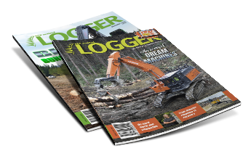
About 40 minutes south east of Dunedin we turn onto a logging road to see a wide open, high volume, Sumitomo-heavy skid (there’s seven) spread out before us at Ollerenshaw Logging’s site with a couple of trucks on site and another one on its way in.
Kelvin Ollerenshaw has come a long way since he was manually logging pulp wood in Scotland. Manually as in chainsawing and then hand bunching postwood length thinnings for the forwarder, but more about that later.
This block lends itself to high production. It’s nice to see a crew in good ground for a change and the crew is taking full advantage, with nice wide haul tracks allowing that big six-wheeled Tigercat 635G skidder to quickly get large volumes of logs to that wide open skid. Olly’s are doing 15 to 20 loads a day. The terrain is mostly cruisy but there are a few very steep, tricky gullies which have needed the crew’s skills brought to bear, along with a keen eye on the weather, to log them.
We’re here today to test the third Sumitomo SH300 that Olly’s has had in the felling role. They like them so much they kept the last one as a spare and it’s still looking like a good frontline machine.
Regular SH300-6 operator, Jared Melvin, says the dash six has wicked track power and wicked power in general. Jared is also Foreman of the crew and first got into logging at 15 after doing a Telford course of general requirements and after a bit of work experience his first day at work was with Chris Hurring, felling trees. He worked there for about four years and then came to work for Olly’s and has been here 17 years.
“I’m part of the furniture,” he says cheerfully.
Jared has lived and breathed logging his whole working life and watching him throw trees down the hill and use the head to jump turn the machine with rapid familiarity it’s obvious we’ve got another maestro on our hands here. It’s the sort of thing you could watch for hours if you weren’t also trying to get out of the crew’s way so they can maintain production.
“I put my hand up to operate our first felling machine,” Jared says. “That was a SH300-5 and the concept of machine felling was quite new back then but I was keen to try it out and I’ve done about 24,000 hours on them now, so I kind of know what’s going on.”
And that’s how you make a maestro – plenty of seat time putting in the hard work plus the machine having the power, speed and smoothness so the man and machine run as one like a hunting predatory animal.
Jared comments, “That first machine had a fell and trim head on it which I found pretty good. With this straight felling head we are towing a bit of excess weight out on the skidder and we end up with branches...

















